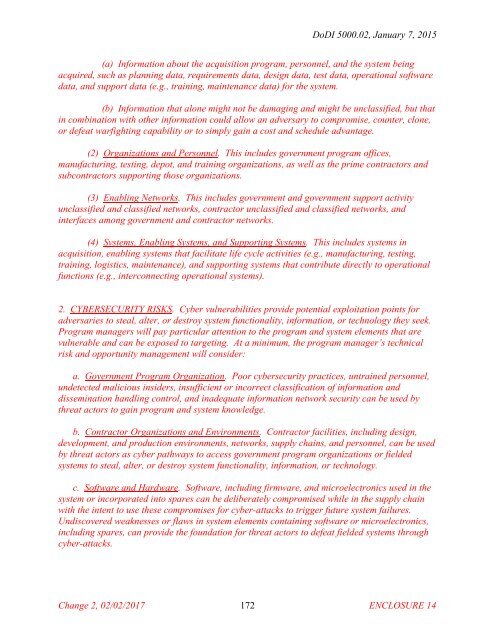Department of Defense INSTRUCTION
x9tnk
x9tnk
You also want an ePaper? Increase the reach of your titles
YUMPU automatically turns print PDFs into web optimized ePapers that Google loves.
DoDI 5000.02, January 7, 2015<br />
(a) Information about the acquisition program, personnel, and the system being<br />
acquired, such as planning data, requirements data, design data, test data, operational s<strong>of</strong>tware<br />
data, and support data (e.g., training, maintenance data) for the system.<br />
(b) Information that alone might not be damaging and might be unclassified, but that<br />
in combination with other information could allow an adversary to compromise, counter, clone,<br />
or defeat warfighting capability or to simply gain a cost and schedule advantage.<br />
(2) Organizations and Personnel. This includes government program <strong>of</strong>fices,<br />
manufacturing, testing, depot, and training organizations, as well as the prime contractors and<br />
subcontractors supporting those organizations.<br />
(3) Enabling Networks. This includes government and government support activity<br />
unclassified and classified networks, contractor unclassified and classified networks, and<br />
interfaces among government and contractor networks.<br />
(4) Systems, Enabling Systems, and Supporting Systems. This includes systems in<br />
acquisition, enabling systems that facilitate life cycle activities (e.g., manufacturing, testing,<br />
training, logistics, maintenance), and supporting systems that contribute directly to operational<br />
functions (e.g., interconnecting operational systems).<br />
2. CYBERSECURITY RISKS. Cyber vulnerabilities provide potential exploitation points for<br />
adversaries to steal, alter, or destroy system functionality, information, or technology they seek.<br />
Program managers will pay particular attention to the program and system elements that are<br />
vulnerable and can be exposed to targeting. At a minimum, the program manager’s technical<br />
risk and opportunity management will consider:<br />
a. Government Program Organization. Poor cybersecurity practices, untrained personnel,<br />
undetected malicious insiders, insufficient or incorrect classification <strong>of</strong> information and<br />
dissemination handling control, and inadequate information network security can be used by<br />
threat actors to gain program and system knowledge.<br />
b. Contractor Organizations and Environments. Contractor facilities, including design,<br />
development, and production environments, networks, supply chains, and personnel, can be used<br />
by threat actors as cyber pathways to access government program organizations or fielded<br />
systems to steal, alter, or destroy system functionality, information, or technology.<br />
c. S<strong>of</strong>tware and Hardware. S<strong>of</strong>tware, including firmware, and microelectronics used in the<br />
system or incorporated into spares can be deliberately compromised while in the supply chain<br />
with the intent to use these compromises for cyber-attacks to trigger future system failures.<br />
Undiscovered weaknesses or flaws in system elements containing s<strong>of</strong>tware or microelectronics,<br />
including spares, can provide the foundation for threat actors to defeat fielded systems through<br />
cyber-attacks.<br />
Change 2, 02/02/2017 172<br />
ENCLOSURE 14


